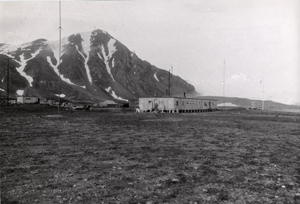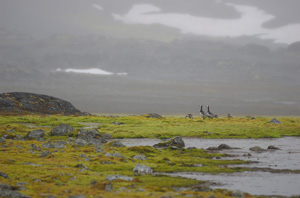Isbjørnhamna – Polska Stacja Polarna [77° 00' N 15° 33' E]By Øystein Overrein (ed.), Jørn Henriksen, Bjørn Fossli Johansen, Kristin PrestvoldThe Polish research station in Hornsund is the only year-round station out in the field in Svalbard. It has been active in Polish research since the International Geophysical Year of 1957–1958, apart from only a few years break. The Poles hold more local knowledge about this fjord than anyone else. The station is worth visiting as an example of an Arctic outpost. The summer is very busy, with scientists working here for short periods, personnel being exchanged, and all the preparations for the winter season that need to be carried out. Therefore, visitors are encouraged to schedule visits with the station well in advance. Upon landing in Isbjørnhamna visitors are often invited in to the station in small groups. Take care:



Isbjørnhamna is beautifully situated on the northern shores of Hornsund, between Wilczekodden and Hansbreen – right across from Gåshamna. Isbjørnhamna was given the name Bowles Bay by Fotherby in 1613 and is considered the best natural harbour on the northern shores of Hornsund. Isbjørnhamna was important during the Norwegian overwintering trapping, but there is little trace left of the cabins that once were used as satellite stations here. The first trapper station in Isbjørnhamna was a satellite station built by two Swedes in 1908. In 1919, Anders Kvive Andersen from Tromsø and Ture Lifbom from Sweden built a new satellite station on the site. The overwintering was organized by Johan Hagerup. Kvive Andersen was unlucky and got shot in his foot by a self-firing gun trap. On the inside of the cabin door it is written: This house belongs to A. Hagerup, Tromsø. Not far from the cabin there is a sign that tells of a different ownership: Owned by Northern Exploration Company Co., London. However, all NEC property was taken over by the Norwegian state in 1932. The satellite station at Isbjørnhamna was used a lot by the famous female trapper Wanny Woldstad and her husband Anders Sæterdal. They overwintered several times in Isbjørnhamna in the 1930s, but the main station was located in Hyttevika. In the winters of 1933–1934 and 1934–1935 Wanny brought her two teenage sons, Alf and Bjørvik. During this time the boys, who were 16 and 17 in 1933, had 25 trips to Isbjørnhamna, sometimes accompanied by an adult and sometimes alone. They only took four trips to Gnålodden, but they took care of the traps in that direction during day-trips out of Isbjørnhamna. At Wilczekodden, not far from Isbjørnhamna, a main station was established in 1908 by Arthur Oxaas, still standing today. Today, the only station in Isbjørnhamna is the Polish research station. During the latter part of the 1960s Fredrik Rubach and Odd Ivar Ruud used the research station as a trapping station until it again was claimed by the Poles. Poland has conducted research longer than most other nations in Svalbard. More than anything, a visit to this area is a great opportunity to see how an Arctic outpost is operated. There are several buildings and many antennas and satellite dishes that secure communication with the outside world. The main building holds a mess and a lounge, laboratories and sleeping quarters for the personnel. In the summer it is often crowded with visiting scientists from different countries. Additionally, Polish research vessels often stay in the area in summer. At the station they maintain polar traditions by keeping Greenland huskies as polar bear guards. They probably also serve a social need during the dark winter months, when there are few people at the station. The coastal flats around the station are characteristic of the south-west Spitsbergen coast. The bedrock consists of marble and garnet mica schist. The latter provides for nutrient-rich soil, which is additionally enriched by grazing birds in the summer: moss tundra vegetation thrives in this area. Visitors often combine a visit to the station with a visit to the little auk colony that is located about 1 km away. Follow the beaten track across the tundra until you reach a little terrace just in front of the scree, perfect for observing the birds. Ornithologists often work here, collecting data, counting and monitoring the colony. Every day the little auks fly off shore to feed on small crustaceans. Off the west Spitsbergen coast the water masses are dominated by both the warm West Spitsbergen Current, which is a branch of the North Atlantic Current, and by cold Arctic water from the East Spitsbergen Current (this current turns at Sørkapp and flows northward along the west coast of Spitsbergen). The two water masses have different plankton communities and by studying the prey items the little auks bring back to the colony, the scientists can monitor the changing climatic regimes in the area, which are related to the distribution of warm and cold water masses. The little auk has a food-pouch under the bill, which allows scientists to take samples of the prey items. There are good chances of meeting reindeer along the track between the station and the colony. Arctic skua and geese also nest in the area, so be extra careful during the goose nesting season that lasts until the end of July. Vulnerable elementsThe moss tundra around the station and along the track to the little auk colony is sensitive to being trodden upon. Geese and other species on the tundra are vulnerable to disturbance. Landing sitesLand at the beach right below the storehouse. Recommended trailsFrom the scree where the little auks nest, there is a good view of the whole area and the station. From the terrace in front of the scree, where scientists often work, there is a good view of the little auks. Updated March 2015 |
The Cruise Handbook is also available in book formHard cover with numerous pictures - 249 pages - NOK 249.00 Norwegian Polar Institute |
 Norsk
Norsk